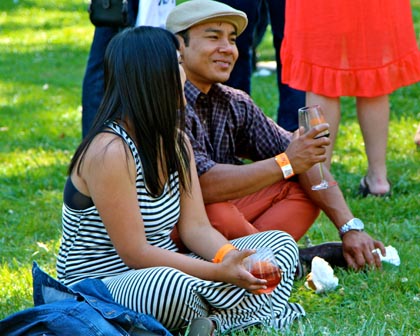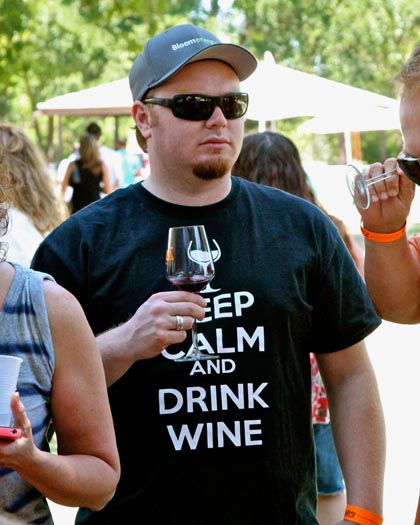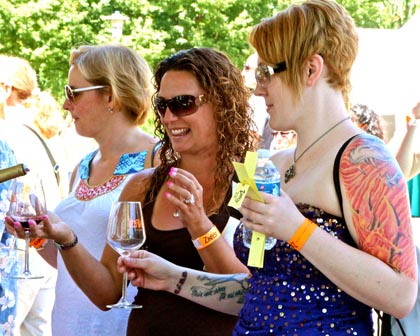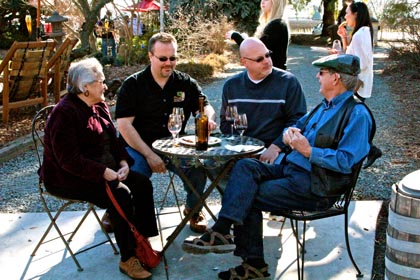Letters from Lodi
An insightful and objective look at viticulture and winemaking from the Lodi
Appellation and the growers and vintners behind these crafts. Told from the
perspective of multi-award winning wine journalist, Randy Caparoso.
What a wine lover wants in 2014
The face of “new” wine lovers at 2013 Lodi ZinFest
What are wine lovers looking for in 2014? Whatever it is, you can be sure that the Lodi is in the thick of it — as America’s largest American Viticultural Area, it has to be. Let's break it down, according to some of the buzz we are hearing in the opening days of the New Year:
The "new American wine”
In a recent piece in The Washington Post, longtime industry observer Dave McIntyre projects the evolution of what he calls "the new American wine," strongly influenced by steadily growing consumer interest in wines grown and produced in states other than California (i.e. the "drink local" mantra). Writes McIntyre:
What does the new American wine taste like? Because so much of it is coming from outside California (although the Golden State still dominates every statistical analysis of U.S. wine production), the wines are less ripe and alcoholic, combining a European sense of balance with American flair. They might use unusual grape varieties, such as Petit Manseng or Chardonel, as vintners discover which vines grow best where. Grape varieties could become less important as winemakers focus more on expressing the voice of their vineyards, often with blends that don't follow traditional wine paradigms. The new American wine is a wine of place, proud of where it comes from and proud of its diversity.
Millennial women: a huge chunk of today’s wine consumers
As for California wines, McIntyre adds:
These trends are happening inside California as well… we will hear more about moderating alcohol levels as winemakers, such as those in In Pursuit of Balance and other groups, redefine ripeness. The sledgehammer wines with 15% alcohol might not be extinct, but their heyday has passed.
Or has it? There is probably not a winery out there, particularly on the West Coast, that has not noticed a growing consumer interest in wines with less alcohol, less fruitiness, and less obvious oakiness. Nevertheless, the days of lean, tight, 12% alcohol wines are long gone. The reason why Californians, in particular, were producing wines that way 30, 40 years ago was because they didn't have better ways of doing it: trellising and viticultural practices of the past made it difficult to ripen grapes beyond 22° or 22.5° Brix (sugar levels that convert to just 12% to 13% alcohol and usually diminished fruit expression). It wasn't a style choice, it was the only choice.
Yet McIntyre makes a good point about the increased exposure to European wines influencing Americans' taste in wine. But face it: the reason why bigger, riper, oakier wines became popular in the first place was not only because viticultural and winemaking improvements made it possible, but also because consumers (not to mention most of the point-scale critics) have liked them that way. Tastes may be changing again – moderation may be on its way — but it doesn't happen overnight: consumers need time to gravitate to lower key styles, as well as the concept of alternative varietals (and Lodi, as it were, grows by far the largest variety of wine grapes than any other region in the world).
2013 Lodi ZinFesters
A "new American wine" is on its way. It's just a matter of waiting for growers, producers, consumers and all facets of the sales industries to smoothly align on the same page.
No matter, wine is trending
A couple of other recent news stories have made note of the fact that, no matter what the style or type, wine is trending as a drink of preference. Fred Tasker of McClatchy Newspapers noted earlier in the month that while beer is still the nation's favorite alcoholic beverage, "Americans are continuing our love affair with wine… we love wine… we drank more last year (2013) for the nineteenth year in a row – up 2% to 360 million 12-bottle cases, according to wine consultants Gomberg, Fredrickson & Associates.”
The aging Boomers may be America's largest population segment, but you cannot ignore the impact of so-called Millennials. In the Huffington Post, Leora Kalikow writes that Millennials – now transitioning from their twenties to early thirties, while growing in spending power – may be perceived as a "flighty, flaky bunch," but their habits "are more in line with the experience of wine than any generation ever before."
The thirty-ish crowd, after all, is the one that has grown up the most saturated in our modern day "foodie culture," as Kalikow puts it; and wine more than any other beverage (beer, cocktails, etc.) fits in with the latest generation's "culinary endeavors." Wine is, after all, a beverage that originally evolved as something consumed with food, like a food – which is another reason styles and tastes are bound to change, as Millennials continue to exert their influence. Leading us to this further development…
Lodi wine lover
Wines that benefit from oak, not taste like oak
Ancient people around the Mediterranean Basin discovered the advantages of aging wine in oak barrels over 2,000 years ago. The operative term is "aging." The ancients used wooden vessels because it was (and still is) the ideal way to garner the benefits of the oxidative process of barrel aging – that is, the making of a smoother, finer wine. They weren't, however, interested in wines that tasted like oak barrels; which is why in most parts of Europe, where winegrowing has been going on for centuries, the obvious taste of oak in a wine is considered a flaw, not a quality.
Most of Lodi's wine producers, like that of many other American wine regions, are far newer to the art of winemaking than Europeans; and new winemakers everywhere tend to fall in love with the idea of wine having the distinct taste of fancy, new, expensive oak barrels, often more so than the grapes from which their wines are made. But in recent years, Lodi wine producers have been steadily moving away from that – a sign of maturity also reflected in the tastes of consumers, as well as the wine journalists (slowly but surely) and gatekeepers (retailers and restaurateurs) who influence consumers.
If you've been following Lodi wines for a while, as you taste through wines in 2014 it is almost guaranteed that you'll find that most of them are tasting less oaky than they were just a few years ago. We even have a notable winery (Acquiesce) that refuses to buy any oak barrels — try to find that elsewhere in California. This has been a good thing, because there's nothing special about a wine that tastes mostly like a barrel. Wines like this could come from anywhere – California, Texas, France… Georgia in the U.S.A. or Georgia in Eastern Europe. If you buy a wine grown in Lodi it should taste like Lodi; and thank goodness, more of them are tasting exactly like that: with the lush, zippy, sun kissed taste of Lodi grapes and earth.
More wines defined by sense of place
The evolution of wines tasting more like their vineyard source is not exactly the same as wines tasting more like grapes. Lodi, for instance, grows more Cabernet Sauvignon than Napa Valley and Sonoma County combined; but aside from the Cabernet Sauvignons made by the Mettler Family, Michael David Winery, and a couple of other wineries, Lodi does not have nearly the reputation as Napa or even Sonoma for top quality Cabernet Sauvignon. This is because most of Lodi's Cabernet Sauvignon grapes are farmed for large production bottlings, rather than for specialty premium labels highlighting individual vineyards.
2013 Lodi ZinFest
In other words, you can produce an excellent wine from a first class grape like Cabernet Sauvignon; but to develop a great reputation for Cabernet Sauvignon, you need to produce a large body of Cabernet Sauvignon bottlings that taste distinctly of individual vineyards or sub-regions: the way that producers like Beaulieu, Robert Mondavi, Caymus, et al. have done over several decades in Napa Valley, or the way famous châteaux such as Lafite-Rothschild, Latour and Margaux have been doing for over a two centuries with their Cabernet Sauvignon based wines in Bordeaux, France.
The best wines in the world, in other words, are defined primarily by how distinctly they taste of where they come from. This is why, after centuries and centuries of winegrowing culture, all of the official quality classification systems in Europe are based upon identification and regulation of regions, sub-regions, and long established vineyards – not so much grapes, brands, producers, winemaking standards, etc
How far along is Lodi on this path? Most wine lovers outside the Delta are not quite aware of it, but slowly but surely a couple dozen or so wineries have been producing Lodi grown wines that emulate Napa Valley and Bordeaux in the sense that they are producing more wines aimed towards vineyard expression. The geeky word for this is terroir, which basically refers to "sense of place" — something perceptible on a sensory level (not just an intellectual one). They are doing it, however, mostly with Zinfandel, since Zinfandel is Lodi's most widely planted grape; still dominating our oldest (60 to over 100 years) and best winegrowing sites.
But hey, this is not an overnight thing either. Most consumers and industry movers and shakers still define American wine quality primarily in terms of "varietal character" or sheer intensity, and 100-point score systems continue to have an impact. But here in 2014, at least we are beginning to see a start towards different permutations of what people really want in a wine. If anything, Lodi has come a long way, baby – especially since the days when everything went into packages not "sold before its time."
Good times at Lodi’s Macchia Winery





